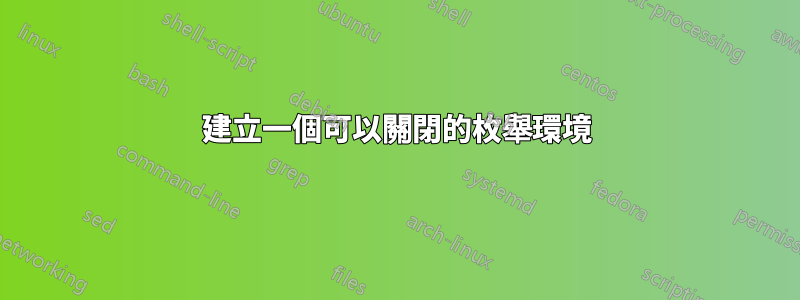
這個問題導致了一個新的包:
comment_io
我想使用枚舉環境建立一個文檔,然後可以在編譯之前打開和關閉該環境。
例如,假設我有一個如下所示的部分:
\begin{enumerate}
\item This is a test.
\item This is another test.
\item This is yet another test.
\end{enumerate}
在正常情況下,這將編譯為包含三個項目的枚舉列表,如下所示:
1. This is a test.
2. This is another test.
3. This is yet another test.
我希望有一種方法可以讓這個特定的枚舉環境消失,以便編譯後的輸出看起來像這樣:
This is a test. This is another test. This is yet another test.
此外,我希望能夠針對不同的環境在全域範圍內執行此操作(也就是說,不必在本機層級編輯相關環境的每個實例)。
但是,我仍然希望能夠在我的文件中保留其他枚舉環境(即使它們嵌套在消失的環境中)。
上下文:我想使用 Tractatus 風格來編寫我的文本,將每個部分放在列舉的層次結構中。但是,我還希望能夠刪除此枚舉並僅將文字顯示為常規文章。最後,在這篇常規文章中,我希望能夠顯示枚舉清單(這樣就不會成為 Tractatus 枚舉的一部分)。
答案1
為了允許嵌套enumerate(或其他清單)環境仍然起作用,您需要捕獲\item是否要在這個新的 on-off 中使其成為無操作enumerate。為此,我們將其定義儲存在序言中,並在每次enuemrate使用開始時重新使用它etoolbox的\AtBeginEnvironment.如果您也計劃嵌套其他列表,則需要\item以類似的方式恢復。
下面我定義了enumerate*在編譯期間關閉的功能,同時它仍然支援巢狀enumerate:

\documentclass{article}
\usepackage{etoolbox}
\AtBeginEnvironment{enumerate}{\let\item\olditem}
\let\olditem\item
\newenvironment{enumerate*}
{\par\let\item\relax}
{\par}
\begin{document}
\begin{enumerate*}
\item Something
\begin{enumerate}
\item Something else
\item Another thing
\begin{enumerate*}
\item This is it
\item This is another it
\end{enumerate*}
\end{enumerate}
\item Last thing
\end{enumerate*}
\end{document}
enumerate*重新定義\item為不執行任何操作 (be \relax)。因此,它會完全忽略任何可選參數(如果有)。也就是說,\item[<stuff>]將預設為[<stuff>].如果需要,可以對其進行調整以吞噬可選參數。
也可以透過 插入垂直調整enumerate*。
答案2
感謝您的所有回答。然而,最後,在費盡心思嘗試讓所有不同的方法發揮作用之後,我只是決定用 Python 編寫自己的腳本,根據包含在其中的某些命令註釋掉(和取消註釋)行。
因此,例如,如果我的原始文件如下所示:
\begin{document}
\begin{enumerate}
\item
This is a test.
\item
This is another test.
\item
This is yet another test.
\end{enumerate}
\end{document}
我想要關閉所有這些枚舉內容的選項,我只需在每行末尾添加一個小命令,我希望能夠註解掉它,如下所示:
\begin{document}
\begin{enumerate} %@
\item %@
This is a test.
\item %@
This is another test.
\item %@
This is yet another test.
\end{enumerate} %@
\end{document}
讓我的腳本發揮其魔力,將文件變成如下所示:
\begin{document}
%@ \begin{enumerate}
%@ \item
This is a test.
%@ \item
This is another test.
%@ \item
This is yet another test.
%@ \end{enumerate}
\end{document}
這可能看起來很麻煩,但對我來說,這絕對是最好的解決方案,因為我知道發生的一切。
如果有人想使用或查看這個用 Python 寫的程序,可以在CTAN。
答案3
使用 acc 定義一個新環境enumitem。根據您的需求:
\documentclass{article}
\usepackage{enumitem}
\newlist{myenum}{enumerate*}{3}
\setlist[myenum]{leftmargin=!,label=\arabic*.}
\begin{document}
\begin{myenum}
\item This is a test.
\item This is another test.
\item This is yet another test.
\begin{myenum}[label=]
\item Second level This is a test.
\item This is another test.
\item This is yet another test.
\begin{myenum}[label=\roman*.]
\item Third level This is a test.
\item This is another test.
\item This is yet another test.
\end{myenum}
\end{myenum}
\end{myenum}
\end{document}
答案4
這幾乎可以完成您的用例中的工作。對於更高級的枚舉環境或選項,它可能不穩健 - 它不會按照您的意願處理嵌套。

\documentclass{article}
\usepackage{etoolbox}
\newtoggle{killenumerate}
\toggletrue{killenumerate}
\newenvironment{myenumerate}
{\iftoggle{killenumerate}
{\renewcommand{\item}{}}
{\begin{enumerate}}
}
{\iftoggle{killenumerate}
{}
{\end{enumerate}}
}
\begin{document}
Enumeration switched off selectively in preamble.
\begin{myenumerate}
\item One item in myenumerate environment
\item Two
\item Three
\end{myenumerate}
\begin{enumerate}
\item One item in ordinary enumerate
\item Two
\item Three
\end{enumerate}
Enumeration switched on for the rest of the document.
\togglefalse{killenumerate}
\begin{myenumerate}
\item One item in myenumerate environment
\item
\item Two
\item Three
\end{myenumerate}
\end{document}


